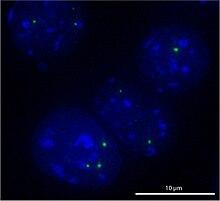Cajal body

Cajal bodies (CBs) also coiled bodies, are spherical
tumor cells, or metabolically active cells like neurons. CBs are membrane-less organelles and largely consist of proteins and RNA. They were first reported by Santiago Ramón y Cajal in 1903, who called them nucleolar accessory bodies due to their association with the nucleoli in neuronal cells.[1] They were rediscovered with the use of the electron microscope (EM) and named coiled bodies, according to their appearance as coiled threads on EM images, and later renamed after their discoverer.[2] Research on CBs was accelerated after discovery and cloning of the marker protein p80/Coilin.[3] CBs have been implicated in RNA-related metabolic processes such as the biogenesis, maturation and recycling of snRNPs, histone mRNA processing and telomere maintenance. CBs assemble RNA which is used by telomerase to add nucleotides to the ends of telomeres.[4]
History
CBs were initially discovered by neurobiologist
RNase together, but not alone, caused dramatic changes to the structure of CBs.[5]
Localization
Cajal bodies are found in all eukaryotes that have been carefully studied.[6] The cells in which Cajal bodies are most apparent usually demonstrate high levels of transcriptional activity, and are often dividing rapidly.[7]
Cell cycle
They are about 0.1–2.0
transcription machinery of the nucleus.[8]
Functions
CBs are bound to the
RNA component of telomerase
(TERC). TCAB1 recognizes the CAB sequence in both and recruits telomerase to the CBs.
CBs contain high concentrations of
biogenesis of enzyme telomerase, and assist in subsequent transport of telomerase to telomeres.[11][12]
References
- ^ Cajal SR (1903). "Un sencillo metodo de coloracion selectiva del reticulo protoplasmico y sus efectos en los diversos organos nerviosos de vertebrados e invertebrados". Trab Lab Investig Biol Univ Madr. 2: 129–221.
- PMID 10588665.
- PMID 2033369.
- PMID 21549308.
- PMID 5813971.
- PMID 20504965.
- PMID 12379800.
- S2CID 8547149.
- PMID 2088441.
- PMID 20504965.
- PMID 16319170.
- PMID 16339074.
